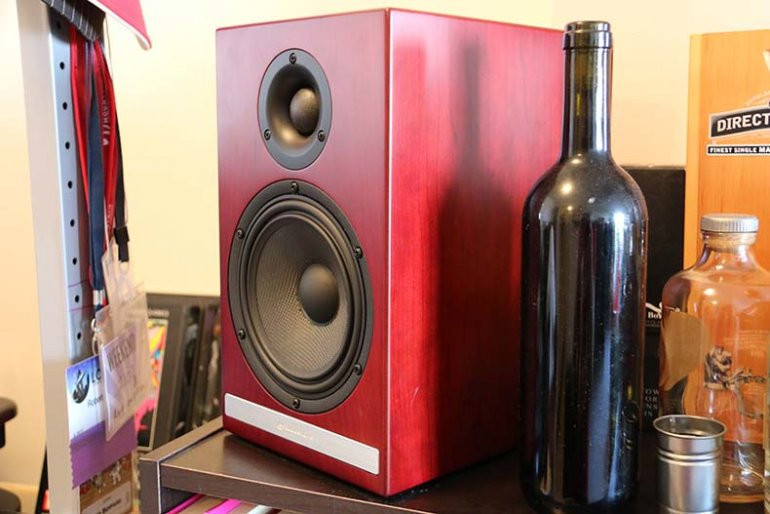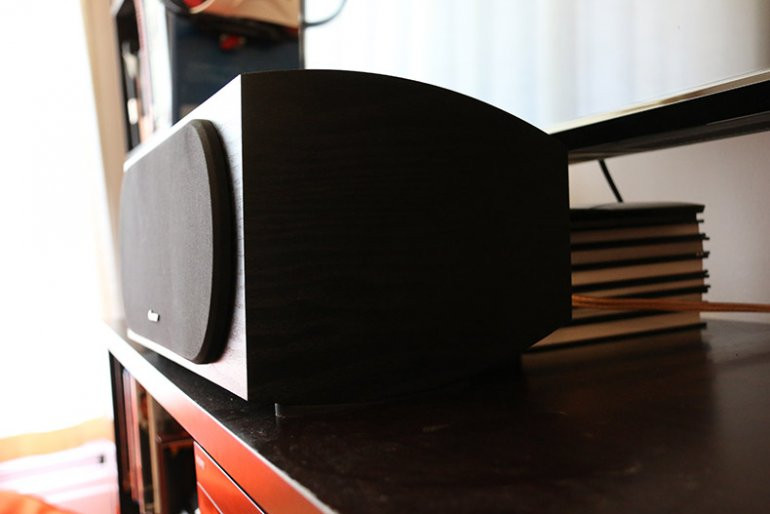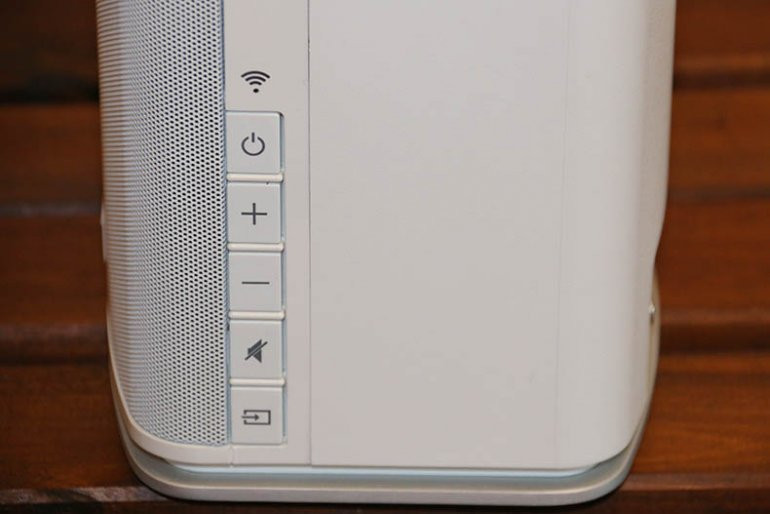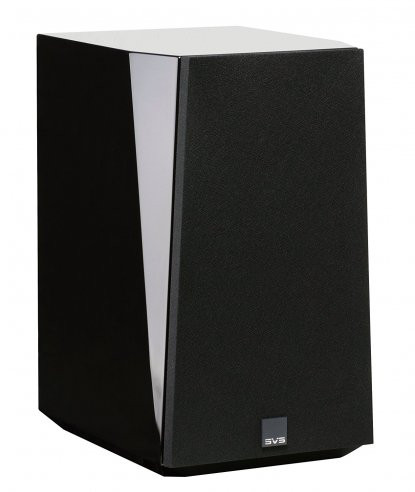Do Wireless Speakers Sound As Good As Wired speakers? Yes, wireless speakers can sound as good as wired speakers, thanks to advancements in technology, providing exceptional audio fidelity for enjoying your favorite music and sounds. At streetsounds.net, we help you explore the world of wireless audio.
1. Understanding the Core of the Wireless vs. Wired Debate
The age-old question: Do wireless speakers sound as good as wired speakers? Historically, wired speakers held the crown for superior sound quality. The traditional belief stemmed from the fact that transmitting audio signals through physical wires allowed for a greater amount of data to be transferred more efficiently than wireless signals. More data translated to higher fidelity sound, leaving wireless speakers lagging behind in audio performance.
However, the landscape of audio technology has dramatically evolved. Wireless technology has made significant strides, closing the gap in sound quality between wireless and wired options. While the argument for wired speakers delivering better audio fidelity still holds weight, especially in high-end audio setups, the advancements in wireless technology are undeniable.
 Audioengine HDP6s used in a blind test, showcasing the debate between wired and wireless sound quality
Audioengine HDP6s used in a blind test, showcasing the debate between wired and wireless sound quality
2. The Technological Leaps in Wireless Audio Quality
Several factors have contributed to the improved sound quality of wireless speakers:
- Wi-Fi Transmission: Transmitting audio over Wi-Fi allows for handling a substantial amount of data, significantly improving sound quality. Wi-Fi offers greater bandwidth compared to earlier wireless technologies, enabling the transmission of richer, more detailed audio signals.
- Bluetooth Advancements: Bluetooth standards have continuously improved, with the latest protocols, such as Bluetooth 5.3, capable of handling vast amounts of data. These advancements result in enhanced depth and detail in the audio output. Bluetooth technology now supports higher bitrates and more efficient encoding, which translates to better sound.
- Speaker Design Innovations: Enhanced driver technology, better power management, and innovative speaker designs have allowed wireless speaker manufacturers to match and sometimes exceed the performance of their wired counterparts. Modern wireless speakers often incorporate advanced digital signal processing (DSP) to optimize audio output and compensate for limitations in speaker size or design.
3. Wireless vs. Wired: A Practical Sound Quality Test
To directly address the question of whether wireless speakers can compete with wired speakers in terms of sound quality, a blind test was conducted. This test aimed to provide practical insights into the audio performance of both types of speakers under controlled conditions.
3.1. Setting Up the Experiment
The experiment involved a side-by-side comparison using closely matched speakers from Audioengine. The setup included:
- Audioengine HDP6 Wired Bookshelf Speakers: These served as the wired benchmark.
- Audioengine HD6 Wireless Speakers: These were the wireless counterparts, designed to be as similar as possible to the wired version.
To ensure a fair comparison, both speaker sets were positioned in the same location in the testing room and connected to the same sound source. The wired speakers were powered by a Yamaha HTR-2067 receiver, a stereo amplifier familiar to the testers. A blind test methodology was employed, where participants were unaware of which speaker set was playing.
3.2. Results and Subjective Observations
The results of the blind test revealed subtle differences between the two speaker sets:
- The HD6 wireless speakers exhibited slightly more low-end presence.
- The HDP6 wired speakers provided a touch more detail in the higher frequencies.
However, the most significant finding was that participants found it challenging to definitively label one set as “better” than the other. The audio quality of both speaker sets was deemed perfectly acceptable, highlighting the advancements in wireless audio technology.
3.3. Implications of the Test
While more extensive testing with additional speaker sets would be required for a definitive conclusion, the results strongly suggest that wireless audio has the potential to equal, if not closely rival, the sound quality of wired speakers. This parity is a significant development, indicating that the choice between wired and wireless speakers can now be based more on convenience and features rather than solely on audio quality.
4. Control and Customization: The Wired Speaker Advantage
One of the most significant advantages of wired speakers is the level of control they offer over the finer aspects of sound. This control primarily comes from the ability to choose and customize the components that process the audio signal.
4.1. Digital-to-Analogue Converters (DACs)
In any digital sound system, a DAC is essential for converting digital files (1s and 0s) into an analogue signal that we can hear. With wired speakers, you have the freedom to select an external DAC, which can significantly impact the sound quality. High-quality DACs can reveal more detail, improve dynamic range, and reduce noise, leading to a superior listening experience.
4.2. Amplifiers
An amplifier boosts the analogue signal to an audible level. With wired speakers, you can choose an amplifier that matches your sonic preferences. For example, a tube amp can add warmth and richness to the sound, making it ideal for genres like soul and hip-hop. Alternatively, a solid-state amp can provide clean, precise clarity, which is excellent for rock and other detail-oriented genres.
4.3. Customization Options
The ability to select and combine different DACs and amplifiers allows for a highly customized audio setup. This level of control is not typically available with wireless speakers, where these components are integrated into the speaker itself. For audiophiles and enthusiasts who enjoy fine-tuning their audio systems, wired speakers offer unparalleled flexibility.
5. Simplicity and Versatility: The Wireless Speaker Edge
While wired speakers excel in control and customization, wireless speakers shine in simplicity and versatility. The primary advantage of wireless speakers is the absence of wires, making setup and placement incredibly easy.
5.1. Ease of Use
Setting up a wireless speaker typically involves plugging it into a power outlet, connecting it to your Wi-Fi or Bluetooth, and you’re ready to go. This simplicity makes wireless speakers an excellent choice for those who want a hassle-free audio solution.
5.2. Multi-Room Audio
Wireless speakers are highly versatile, especially when it comes to multi-room audio setups. You can easily place multiple speakers throughout your home and control them centrally, creating a seamless listening experience. Technologies like Play-Fi allow speakers from different manufacturers to communicate with each other, providing even greater flexibility.
5.3. Convenience and Aesthetics
The lack of wires not only simplifies setup but also enhances the aesthetics of your living space. Wireless speakers can be placed discreetly without the need to hide or manage cables. Many wireless speakers also come with sleek, modern designs that blend well with contemporary decor.
6. Making the Right Choice: Wired or Wireless?
Deciding between wired and wireless speakers depends on your specific needs and preferences. Here’s a breakdown to help guide your decision:
6.1. Choose Wired Speakers If:
- Precise Control: You want precise control over every aspect of your sound.
- Component Swapping: You want the ability to swap out components in the future to upgrade or change your sound.
- Wired Setup: You are comfortable with having wires and managing a more complex setup.
6.2. Choose Wireless Speakers If:
- Ease of Use: You prioritize ease of use and a clean, clutter-free setup.
- Seamless Integration: You want a system that integrates seamlessly into your existing gadget ecosystem.
- Multi-Room Audio: You desire a multi-room audio setup with speakers in various locations throughout your home.
7. General Advice for Buying Speakers
Regardless of whether you choose wired or wireless, several factors should influence your speaker purchase:
7.1. Sound Quality
Sound quality is paramount. Different speakers have different sonic characteristics, and the quality often depends on factors like the number of drivers, their size, and the materials used. Determine how much you are willing to spend to achieve the sound quality you desire.
7.2. Loudness
Consider how loud the speakers can go. Loudness is measured in sound pressure level (SPL) or sensitivity. If you have a small apartment, you won’t need speakers that can reach extremely high volumes.
7.3. Number of Speakers
For wired systems, you’ll typically need at least two speakers for stereo sound. For wireless systems, consider the size and layout of your rooms. Determine how many speakers you need to adequately cover each space.
7.4. Ease of Use
Especially for wireless speakers, ensure the system is easy to set up and operate. Look for systems that offer intuitive apps for control and seamless connectivity.
7.5. Aesthetics
Consider how the speakers look and whether they blend with your home decor. Color, shape, and design can all play a role in how well the speakers fit into your living space.
8. Optimizing Speaker Placement for the Best Sound
Proper speaker placement is crucial for achieving the best possible sound quality. Here are some general guidelines:
8.1. Two-Channel Wired Systems
- Spacing: Place speakers about a foot away from the wall.
- Ear Level: Position the largest drivers roughly at ear level when you’re seated.
- Clear Path: Ensure there are no obstructions between the speakers and your listening position.
- Experiment: Spend time experimenting with different positions to find the sound that suits you best.
8.2. Wireless Speakers
The same principles apply to wireless speakers. The advantage is that wireless speakers are easy to move around, allowing you to quickly find the optimal placement.
8.3. Home Theater Setups
- Front Speakers: Place floorstanding speakers on either side of the TV, forming a triangle with your listening position.
- Subwoofer: Experiment by placing the subwoofer in your listening position and crawling around the room to find the spot where the bass sounds best.
- Surround Speakers: Position surround speakers at ear level to the sides and slightly behind your listening position.
 Proper speaker placement is crucial for optimal sound quality
Proper speaker placement is crucial for optimal sound quality
9. The Cable Question: Do Expensive Cables Matter?
The debate over whether expensive cables make a difference is ongoing. Factors like complex resistance and electromagnetic shielding could potentially affect sound quality, but the results are often subtle.
If you are investing heavily in your audio system, spending a bit extra on cables may be worthwhile. However, for basic setups or those on a budget, standard 16-gauge speaker wire will likely suffice.
10. Wireless vs. Wired Home Theater Systems
Wireless home theater systems have made significant advancements, with options like the Sonos 5.1 system offering excellent performance without the hassle of wires.
10.1. Advantages of Wireless Home Theater
- No Wires: The absence of dangling speaker wires simplifies setup and enhances aesthetics.
- Convenience: Wireless systems are easy to set up and integrate into your home.
10.2. Disadvantages of Wireless Home Theater
- Cost: Wireless systems can be expensive.
- Fidelity: While improving, the fidelity of traditional wired systems may still be slightly better.
- Power: Each speaker typically needs to be connected to a power outlet.
11. Wi-Fi vs. Bluetooth: Choosing the Right Connection
The choice between Wi-Fi and Bluetooth depends on your specific needs:
11.1. Wi-Fi Advantages
- Higher Data Transmission: Wi-Fi can transmit more data at higher speeds, resulting in better audio quality.
- Multi-Room Setups: Wi-Fi is more effective for true multi-room setups with different speakers playing in various parts of your home.
11.2. Bluetooth Advantages
- Convenience: Bluetooth is convenient for connecting to mobile devices and offers wide compatibility.
- Advancements: Technologies like aptX and Bluetooth 5.3 have significantly improved audio fidelity.
If you have many internet-connected devices, you may want to avoid Wi-Fi-only speakers. If you have a weak or crowded Wi-Fi signal, consider investing in a device like the Sonos Bridge to increase network capacity.
 The Paradigm PW 600 with Play-Fi connectivity
The Paradigm PW 600 with Play-Fi connectivity
12. Recommendations: Great Wireless Speakers to Consider
- Sonos Five: Excellent user experience, easy setup, and great sound for the price.
- Klipsch The Three II: Confident and punchy sound, with a retro design.
- SVS Prime Wireless Pro: High-quality sound and versatile connectivity options.
13. Recommendations: Great Wired Speakers to Consider
- SVS Ultra: Delivers serious power and fantastic sound quality.
- Audioengine HDP6: Gorgeous wood exterior and good sound for the price.
- SVS Prime Pinnacle: Floorstanding speakers with a big, smooth sound, perfect for home theaters.
 SVS Ultra wired speaker
SVS Ultra wired speaker Audioengine HDP6 wired speaker
Audioengine HDP6 wired speaker
14. Discover Streetsounds.net: Your Gateway to Urban Audio
At streetsounds.net, we are passionate about bringing the vibrant and diverse soundscapes of urban environments to creators and enthusiasts alike. Whether you’re a music producer, filmmaker, game designer, or simply a lover of city sounds, our platform offers a rich collection of high-quality sound effects to enhance your projects and inspire your creativity.
We offer:
- Extensive sound library: Dive into our curated library featuring everything from bustling traffic and lively street performers to the subtle hums of urban infrastructure.
- Expert guidance: Learn from our tutorials on recording and processing street sounds professionally, ensuring top-notch audio quality for your projects.
- Community engagement: Connect with fellow sound enthusiasts, share your work, and collaborate on exciting projects.
- Inspirational content: Explore articles, interviews, and stories about the cultural significance of street sounds and their impact on music and art.
15. Enhance Your Projects with Authentic Urban Soundscapes
Imagine the immersive experience you can create by incorporating the realistic sounds of New York City into your next film or video game. Streetsounds.net provides the tools and resources you need to bring these urban environments to life:
- Music Production: Add unique textures and rhythms to your tracks using authentic street sounds.
- Filmmaking: Enhance the realism of your scenes with background ambience and specific sound effects.
- Game Design: Create immersive and believable urban environments with high-quality audio.
- Art Installations: Craft engaging and thought-provoking soundscapes for your installations.
Ready to explore the sounds of the city? Visit streetsounds.net today and start your auditory adventure. Dive into our extensive library, read insightful articles, and become part of a community that celebrates the art of urban sound. Don’t miss out on the opportunity to elevate your creative projects with the authentic sounds of the streets.
16. Ready to Explore the Urban Soundscape?
Visit streetsounds.net today to discover a world of high-quality street sounds. Explore our library, read our articles, and join our community of sound enthusiasts. Elevate your projects with the authentic sounds of the streets!
- Address: 726 Broadway, New York, NY 10003, United States
- Phone: +1 (212) 998-8550
- Website: streetsounds.net
17. Frequently Asked Questions (FAQs) About Wireless and Wired Speakers
17.1. Do wireless speakers sound as good as wired speakers?
Yes, modern wireless speakers can achieve sound quality comparable to wired speakers, thanks to advancements in wireless technology and speaker design.
17.2. What are the main advantages of wired speakers?
Wired speakers offer greater control over sound customization through separate DACs and amplifiers, providing superior audio fidelity for audiophiles.
17.3. What are the primary benefits of wireless speakers?
Wireless speakers provide ease of use, simple setup, and seamless integration into multi-room audio systems, eliminating the clutter of wires.
17.4. Which type of speaker is better for multi-room audio setups?
Wireless speakers are ideal for multi-room audio, offering easy placement and central control.
17.5. What factors should I consider when buying speakers?
Consider sound quality, loudness, the number of speakers needed, ease of use, and aesthetics when purchasing speakers.
17.6. Does speaker placement affect sound quality?
Yes, proper speaker placement is crucial for achieving optimal sound quality. Follow guidelines for spacing, ear level positioning, and avoiding obstructions.
17.7. Do expensive cables improve sound quality?
The impact of expensive cables on sound quality is debatable. For high-end systems, they may offer subtle improvements, but standard cables are often sufficient for basic setups.
17.8. Are wireless home theater systems worth it?
Wireless home theater systems offer convenience and a clutter-free setup, though wired systems may still provide slightly better fidelity.
17.9. What is the difference between Wi-Fi and Bluetooth speakers?
Wi-Fi speakers offer higher data transmission rates and are better for multi-room setups, while Bluetooth speakers provide convenience and wide compatibility with mobile devices.
17.10. Where can I find high-quality street sound effects for my projects?
Visit streetsounds.net for an extensive library of authentic street sound effects, expert guidance, and a community of sound enthusiasts.


